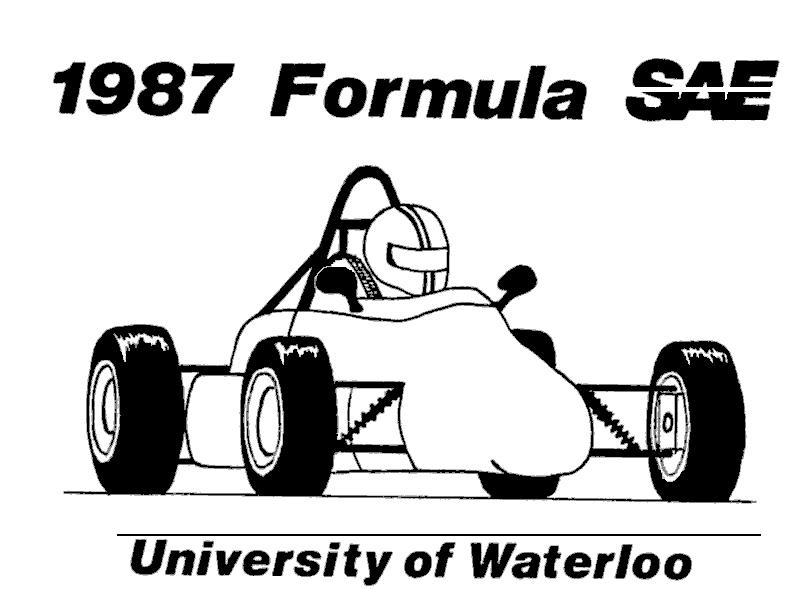With
almost 20 years of history, the University of Waterloo Formula SAE
Team is Canada's longest continuous running FSAE team. Here
is a look back of how it all began in May 1986, what the first car
was like, and how the team did at the 1987 FSAE Competition.
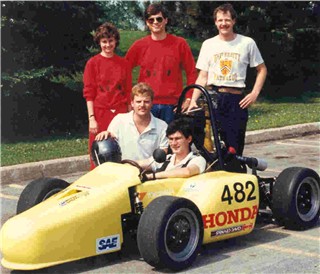
The Team members
Left to right -
Cathy Wilton, Al Ashton (kneeling, joined in the second year),
Chris Clements, Matt Crossley (in car), and Evan Jones. The Team
also had help from Andrew Strilbling and Greg Lamb, although they
did not travel to the event in Texas or participate for course
credit.
Introduction
In 1986, four
mechanical engineering students approached Dr. Allan Hale about
being their supervisor for their fourth year project to design,
build and race the first ever Waterloo entry in the Formula SAE
competition. Dr. Hale agreed and the project began with a trip to
the 1986 FSAE Competition held in Michigan. During that trip the
team saw a lot of pitfalls that they were determined to avoid -
cars being tested for the first time right at the competition,
poor preparation on various aspects of the judging scheme and some
design ideas that were suspect.
Four areas of
activity were highlighted by the team
-
getting
sponsorship money
-
building the
car well ahead of the competition to learn how to drive it
-
learning
techniques needed to effectively drive a race car
-
concentrating
on the presentation and documentation parts of the competition
The team also
decided to choose the simpler route whenever possible thats why
the car was made of mild steel and used a carburetor.
The Sponsors
-
Honda of
Canada provided a 500cc Interceptor engine at no cost
-
Yokahama Tires
provided racing slicks for the car
-
Schleuter Chev-Olds
painted the body Corvette yellow at no cost
-
Wolf Racing
built the exhaust system at cost
-
Bundy Canada
-
Raytheon
Canada
-
Fiberglas
Canada
-
Chevron
-
Waterloo Honda
-
University of
Waterloo, Department of Mechanical Engineering
supplied some cash, most of the raw materials, and performed the
final welding work at no cost
The Car

1987
Car Concept Drawing
Engine
A Honda V4 500cc
engine was chosen for its compact size and good power. Honda
Canada donated one engine. A second engine was taken from a
wrecked bike purchased from a local motorcycle shop. This also
yielded a wiring harness, cooling system and brake parts. It was
decided that a carburetor would be used to keeps things simple
compared to trying to climb the steep learning curve related to
fuel injection. The carburetor was mounted on a unique intake
track that allowed the fuel mixture to gradually expand on its way
down to the engine. The intake tract itself was laid up using
Kevlar over a wax mockup. Once heated, the wax evaporated and a
very smooth intake system was left. Matt Crossley borrowed a
water-driven dynamometer from General Motors (he had work terms at
GM) and this helped greatly in helping tune the engine to maximize
the horsepower.
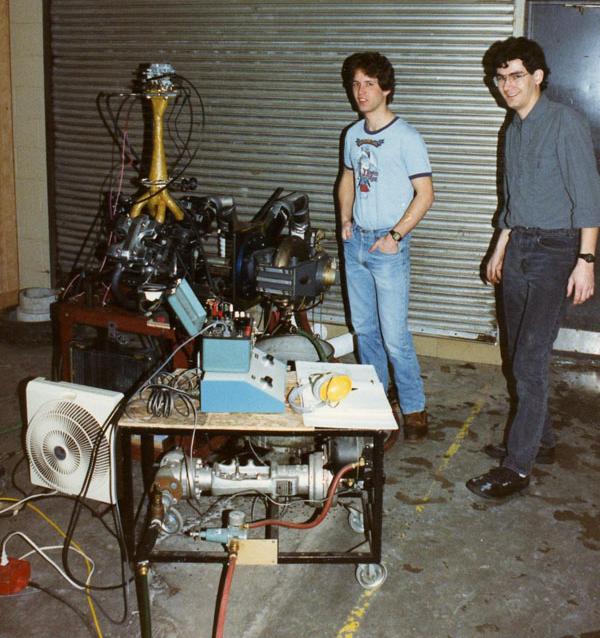
Dynamometer Test Set-up
Chassis
Although heavier
than other materials, mild steel tubing was used throughout the
chassis because it allowed easy fabrication at very low cost.
Steel is also easier to repair as the team discovered after
bumping the front end into a parking lot curb. Chris Clements did
the bulk of the frame and suspension design and the car was
probably the safest car at the competition. The radiator was
mounted on the left side of the car, beside the cockpit. The
added expense and complexity of having two radiators was not
warranted. The team did all of the spot welding and the UW
Engineering Main Shop did all of the final welding of the frame.

Side
View

Top
View
Suspension
The suspension
was independent on all four corners. The front suspension did not
use conventional double A or wishbone design, but a unique system
that used four linkage rods. This was very easy to fabricate and
allowed very fine tuning of the steering and cornering geometry.
The rear suspension had lower A arms, upper and leading linkages.
Used motorcycle shocks were mounted on all four corners. The
front wheels mounted on aluminum uprights and the rear used a
similar aluminum uprights.

Bare
Chassis - Ready for First Test Drive
Power Train
The engine power
used a motorcycle chain to drive a unique differential setup. A
Morris Mini differential (found at an auto junk yard) was mounted
inside a specially designed housing. This housing was rotated by
the chain from the engine. The power was then fed through a
Morris Mini pair of CV joints to the rear wheels.
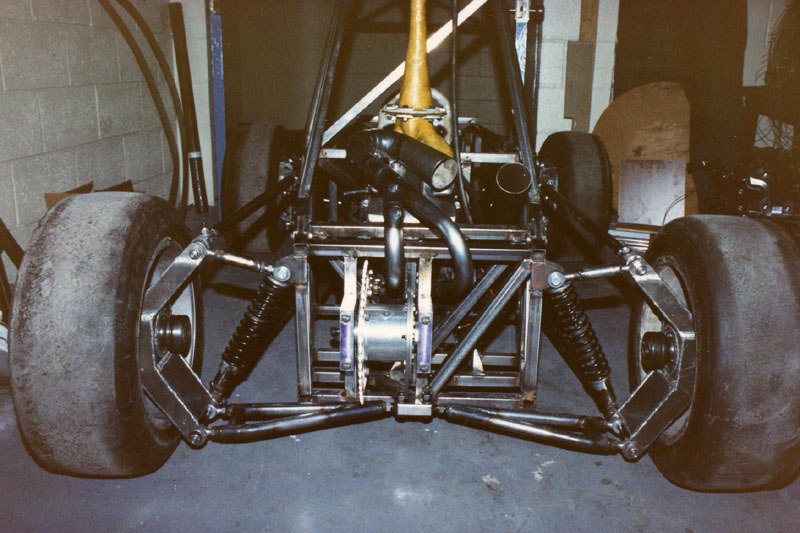
Rear
Suspension and Drive train
Steering and Brakes
A Morris Mini
rack and pinion steering unit was used for turning the front
wheels. The steering shaft was set up to allow the steering wheel
to be adjusted forward and backwards. This was to accommodate the
different sizes of the team members. (Cathy was about 57 and Al
was about 6 3) The rear brake disc was mounted to the
differential housing and the caliper mounted on the rear frame.
Body Work
The body work
was fabricated using a very unusual technique. First, blue
extruded polystyrene insulation (Styrofoam Blue) panels were
placed on the frame and around the radiator. Saws and files were
used to shape the body to the desired contours, including an NACA
scoop in front of the driver. Fiberglass cloth was then laid up
on top of the foam, followed by some minor spot puttying.
The Numbering
Since this was
the first year for
Waterloo
to compete in the event, the team was left to choose whatever
number it wanted for the car. ME462 was the course number for the
fourth year project and so 462 as chosen as the number for the
car.

Test
Driving the Car
The Competition
The 1987 FSAE
Competition was held at the University of
Texas
at Arlington and was spread out over three days.
May 28, 1987 First Day, Static events
Inspections of
the car and review of the documentation, the team placed 5th
overall.
May 29, 1987 Second Day
The
first event was the acceleration event and it was a DISASTER! The
team couldn't seem to get the car off the line without stalling.
After checking the car, a broken spring in the carb secondary was
found and so too were a rock in the primary jet and dirt in the
float bowl. Fixing these things still does not get the
acceleration back. The team earned 0 points for this event
because it did not beat the maximum allowed time. Later that day
the team realized the mistake - Canadian winter gasoline was used
for tuning the car before coming to
Texas!
The team subsequently purchased gas in Texas to run in the dynamic
events. This Texas gas had a lower evaporation rate because of
the higher temperatures and this lead to the acceleration
problems. The team re-jetted the carburetor as best as it could
and managed acceptable scores in the fuel economy (3rd
place) and maneuverability (6th place).
May 30, 1987 Third Day
The team stood
at
5th place overall despite its dismal result in the
acceleration. During warm ups for the endurance event, the
beautiful nose cone came sliding off the front of the car. Out
comes the engineers secret weapon duct tape and the car was
back in business. The car and the group of of drivers performed
beautifully. The team was 1 of only 3 teams that complete
both heats without any mechanical problems. This confirmed the
belief that keeping things simple and making sure that lots of car
testing before the competition would be beneficial. The Team
placed 3rd in the Endurance Event.
The Awards
The team
received the following awards:
-
Special
mention for innovative use of composite materials - the Kevlar
intake manifold had a lot of positive comments.
-
Winner of Team
Sportsmanship - because the team members were not frantically
fixing things most of the time, they spent a lot of time talking
to the other teams and providing tools and food where needed.
-
Best and Most
Complete Costing Report - this reinforced the team's original
emphasis on the static aspects of the competition.
The team
placed 4th overall in the 1987 competition. This was a
remarkable achievement for an first-time entry, especially so when
you consider that it has yet to be beaten by any Canadian team
since then! 1987 was also the year when the annual award-winning
tradition of the University Waterloo Formula SAE Team began.
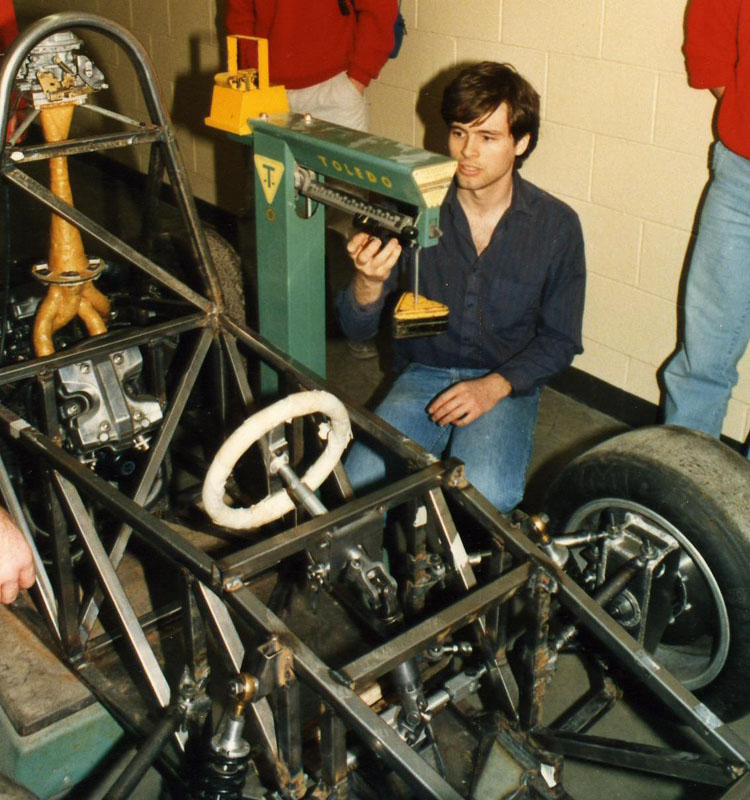
Weighing the chassis

The
car on display
Text
and pictures courtesy of Evan Jones, a member of the 1987 Team.
Edited
by Peter Yang and Will Chan
